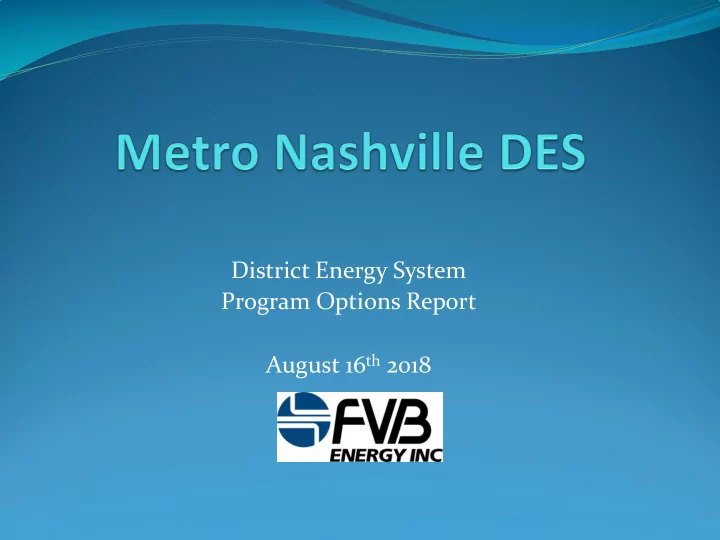

District Energy System Program Options Report August 16 th 2018
DES Project Summary FVB responded to, and was hired after a Request for Proposal (RFP) issuance in 2017 FVB prepared a comprehensive evaluation report for Metro to summarize the in-depth assessment of the economic viability of the DES Options/recommendations are provided for the future of the system Four scenarios are developed and compared
DES Project Scenarios FVB developed and analyzed four primary DES scenarios: No Growth (Business as Usual (BaU)) scenario Based on existing operations with little or no growth Growth scenario Based on expanding the system capabilities and customer base Two different and not mutually exclusive expansion options explored Internal management and operations option Metro retains ownership and internally manages and operates DES Business Exit case Valuations if Metro exits the business
DES Project Scenarios Overview FVB evaluated options for the future of the DES, but no specific option is favored or recommendation explicitly given
DES Project Key Takeaways Regardless of the ownership of DES, an active management structure that takes ownership, has accountability, and encourages growth will need to be put in place It will be necessary to incorporate an effective marketing scheme into the management structure to successfully capture growth opportunities New customers should sign contracts that do not tie debt service to customer revenues, and existing customer contracts need to be revisited and restructured to allow additional capital to flow to the DES to allow for system growth, Energy Generation Facility (EGF) maintenance and improvements, and additional capital expenditure (CAPEX) needs
Scenario Overview DES currently receives a yearly subsidy from Metro in the form of the Metro Funding Amount (MFA) – Fiscal Year (FY) 2019 MFA is $1,640,300 The MFA will go down over time in any scenario, but at different rates NPV (Net Present Value) is the difference between the present value of the benefits of a project and its costs.
BaU Scenario: Takeaways NPV of future MFAs discounted at 4.33%: $4.9 MM without additional CAPEX $10.4 MM with additional CAPEX Sales value will decrease over time: Energy Generation Facility (EGF) equipment will age and require additional CAPEX Contracts will move towards expiration Potential additional growth opportunities will be missed
BaU Scenario: CAPEX Requirements $3,500,000 $3,292,300 $3,000,000 $2,500,000 CAPEX Requirements $2,142,800 $2,000,000 $1,500,000 $1,000,000 $577,500 $687,500 $500,000 $495,000 $0 2019 2020 2021 2022 2023 Fiscal Year CAPEX requirements are estimated and subject to revision. $495,000/year is assumed after starting in 2023.
BaU Scenario: The Metro Funding Amount (MFA) Over Time 2,500 2,000 1,500 USD (in 000's) 1,000 500 - 2017 2018 2019 2020 2021 2022 2023 2024 2025 2026 2027 Year MFA MFA with CAPEX A 10% reduction in System Operator (SO) costs beginning in Fiscal Year 2019 is assumed.
Growth Scenario: Energy Generation Facility (EGF) Expansion Expand the existing EGF to its maximum site capacity by serving additional customers in the growing SoBro area
Growth Scenario: Thermal Energy Storage (TES) Tank Construct a TES to serve additional customers in the downtown area
Growth Scenario: Takeaways Promising option Will require substantial upfront capital investment Energy Generation Facility (EGF) Expansion Present day capital cost: $52.7 MM Investment has a positive return but negative cash flows would need to be funded for the first eight years Thermal Energy Storage (TES) Expansion Present day capital cost: $38.5 MM Investment has a positive return but negative cash flows would need to be funded for the first five years
Growth Scenario: The MFA Over Time The Growth scenario generates a sustained cash surplus starting in 2031, consequently: Contributes to the value of the DES in the long run and demonstrates promise to a potential acquirer. Does not contribute to a more rapid decline of the MFA.
Internal Management and Operations Option: Takeaways Possible cost savings and operational efficiencies to be gained could yield a 19% reduction in annual operations & maintenance (O&M) costs enabling the MFA to be eliminated faster A well-defined transition plan, management structure, and capital plan are needed
Internal Management and Operations Option: The MFA Over Time 2,500 2,000 1,500 USD (in 000's) 1,000 500 - 2017 2018 2019 2020 2021 2022 2023 2024 2025 2026 2027 Year MFA MFA with CAPEX
Business Exit Case: Takeaways Sale of the DES is likely to repay all existing debt obligations The MFA will no longer be required
Business Exit Case: Valuation Metrics Potential growth CAPEX requirements (based on the age and condition of the system) Customer contracts (structure and term) Commodity risk (mitigated by pass-through contract provisions)
Business Exit Case: DES Market Valuation Range with Reduced System Operator Costs and System Growth Valuation* Valuation Net of Debt* $46.7 MM -$4.9 MM $56.1 MM $4.5 MM $65.4 MM $13.8 MM An active market for DE assets and strong market participants suggest that the higher valuation range may be achieved. *DES net debt as of the end of FY 2017 is $51.6 MM.
DES Project Summary FVB developed and analyzed four primary DES scenarios: No Growth (Business as Usual (BaU)) scenario Based on existing operations with little or no growth Growth scenario Based on expanding the system capabilities and customer base Internal management and operations option Metro retains ownership and internally manages and operates DES Business Exit case Valuations if Metro exits the business
Summary of Scenarios BaU Scenario Growth Scenario • • CAPEX funding not adequate Two promising and not mutually • Sales value will decrease over time exclusive growth options • • Will continue to require Will require substantial upfront subsidization through FY 2021 capital investment Internal Management and Operations Business Exit Case • Option Sale of the DES is likely to repay all • Possible cost savings and operational existing debt obligations • efficiencies to be gained could yield a The MFA will no longer be required 19% reduction in annual operations & maintenance (O&M) costs • A well-defined transition plan, management structure, and capital plan are needed
Questions?
Recommend
More recommend